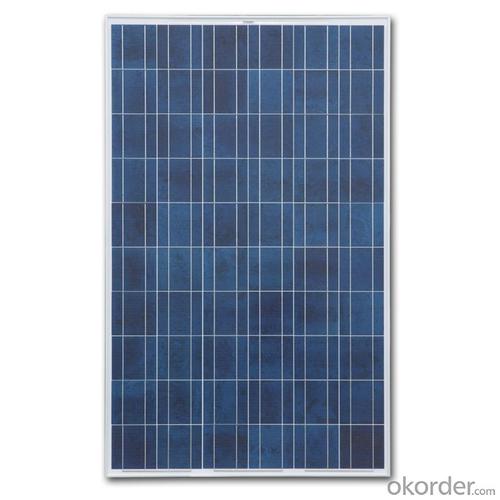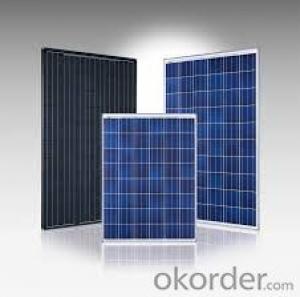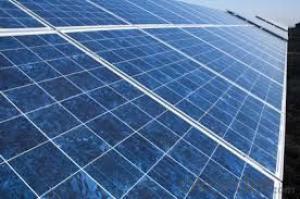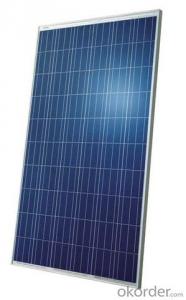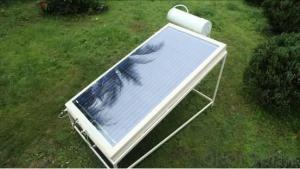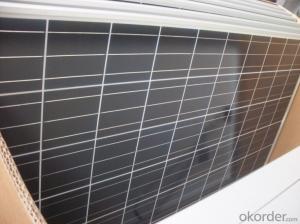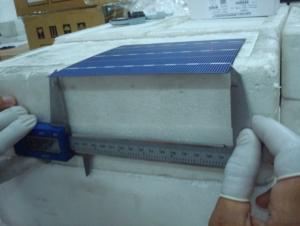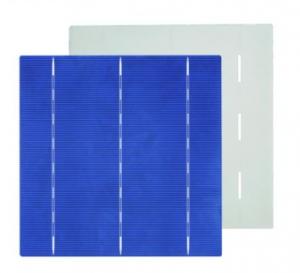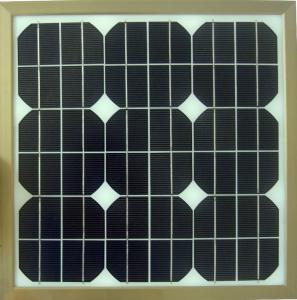Crystalline Si Solar Cells - Factory Wholesale Polycrystalline Solar Panel CNBM
- Loading Port:
- Qingdao
- Payment Terms:
- TT OR LC
- Min Order Qty:
- 10 set
- Supply Capability:
- 300000 set/month
OKorder Service Pledge
OKorder Financial Service
You Might Also Like
Polycrystalline Solar Modules
CNBM offers a range of small, medium and large polycrystalline solar modules, designed for a range of requirements.
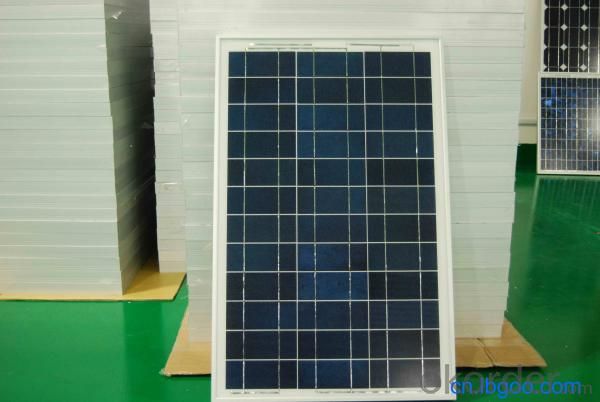

Specifications:
Tolerance | +/-3% |
Cell | Polycrystalline silicon solar cells (156 x 156mm) |
N0. of Cells | 60 (0 x 6) |
Dimension of Modules (mm) | 1650 x 990 x 40 |
Weight (kg) | 25.5 |
Limits:
Operating Temperature | -40~+85? |
Storage Temperature | -40~+85? |
Maximum System Voltage | 1000 VDC max. |
Hail Impact | Diameter of 28mm with impact speed |
Temperature and Coefficients:
NOCT | 48C+/-2? |
Voltage temperature coefficient (%/K) | -0.35 |
Current temperature coefficient (%/K) | 0.05 |
Power temperature coefficient (%/K) | -0.45 |
Characteristics:
Model: | SGM-200P | SGM-210P | SGM-220P |
Max-power voltage Vmp (V) | 29.2 | 29.4 | 29.41 |
Max-power current Imp (A) | 6.85 | 7.14 | 7.48 |
Open-circuit voltage Voc (V) | 36.5 | 36.69 | 36.9 |
Short-Circuit Current Isc (A) | 7.28 | 7.6 | 7.93 |
Max-power Pm(W) | 200 | 210 | 220 |
Model: | SGM-230P |
Max-power voltage Vmp (V) | 29.8 |
Max-power current Imp (A) | 7.72 |
Open-circuit voltage Voc (V) | 37.31 |
Short-Circuit Current Isc (A) | 8.19 |
Max-power Pm(W) | 230 |
STC: Irradiance 1000W/m2, module temperature 25?, AM-=1.5
Poly Crystalline Solar Panels Specifications Range
Maximum Power (Pm) | Dimension | Weight | Operating Voltage (Vmp) | Operating Current (Imp) | Open Circuit Voltage (Voc) | Short Circuit Current (Isc) |
0.45W | 140x80x10mm | 0.08kg | 3.3V | 150mA | 4.6V | 160mA |
1.0W | 162x140x10mm | 0.16kg | 7.5V | 150mA | 10.3V | 160mA |
4.5W | 269x251x23mm | 0.8kg | 16.5V | 0.27A | 20.5V | 0.3A |
10W | 420.1×268.9×22.6mm | 1.92kg | 17.5V | 0.58A | 20.5V | 0.6A |
20W | 425x502x50mm | 3.0kg | 16.8V | 1.19A | 21.0V | 1.29A |
30W | 593x502x22.6mm | 3.9kg | 16.8V | 1.78A | 21.0V | 1.94A |
40W | 655x537x50mm | 5.75kg | 17.3V | 2.31A | 22.1V | 2.54A |
50W | 839x537x50mm | 6.0kg | 17.5V | 2.9A | 21.8V | 3.17A |
65W | 1111x502x50mm | 7.2kg | 17.6V | 3.69A | 22.1V | 3.99A |
80W | 1204x537x50mm | 7.7kg | 17.6V | 4.55A | 22.1V | 4.8A |
- Q: How do solar cells perform in areas with frequent earthquakes?
- Solar cells can perform well in areas with frequent earthquakes, as they are designed to withstand a certain level of structural stress. However, the installation and mounting of solar panels should be done with proper engineering considerations to ensure their stability during seismic events. Additionally, regular inspections and maintenance may be required to address any potential damages caused by earthquakes.
- Q: Can solar cells be used for powering electric water heaters?
- Yes, solar cells can be used to power electric water heaters. By harnessing sunlight and converting it into electricity, solar cells can provide a sustainable and renewable energy source to heat water in electric heaters. This helps reduce reliance on traditional power grids and contributes to a greener and more eco-friendly way of heating water.
- Q: How do solar cells handle hail or other severe weather conditions?
- Solar cells are designed to withstand severe weather conditions including hail. They are made with durable materials such as tempered glass that can handle impact from hailstones. Additionally, solar panels are tested and rated for their ability to withstand extreme weather events, ensuring their resilience in harsh conditions.
- Q: What is the difference between a monocrystalline and polycrystalline solar cell?
- Monocrystalline solar cells are made from a single crystal structure, resulting in a higher efficiency but also higher costs. On the other hand, polycrystalline solar cells are made from multiple crystal structures, making them less efficient but more cost-effective.
- Q: What is the payback period for solar cells?
- The payback period for solar cells depends on various factors such as the initial cost of installation, the amount of electricity generated, and the cost of traditional energy sources in the area. On average, solar cells have a payback period ranging from 5 to 10 years, but in some cases, it can be as short as 3 years or as long as 20 years.
- Q: Can solar cells be used for powering security systems?
- Yes, solar cells can be used for powering security systems. Solar cells are capable of converting sunlight into electricity, providing a sustainable and renewable energy source for various applications, including security systems. By harnessing solar power, security systems can operate independently from the grid, making them more reliable and cost-effective in remote or off-grid locations. Additionally, solar-powered security systems are environmentally friendly, reducing carbon emissions and minimizing reliance on fossil fuels.
- Q: What is the role of solar cells in powering emergency response systems?
- The role of solar cells in powering emergency response systems is to provide a reliable and sustainable source of energy during crisis situations. Solar cells convert sunlight into electricity, which can be used to power critical equipment such as communication devices, lighting, and medical equipment. This ensures that emergency response systems can function effectively even in areas with limited or no access to traditional power sources, enhancing their overall efficiency and responsiveness during emergencies.
- Q: Can solar cells be used in disaster response vehicles?
- Yes, solar cells can definitely be used in disaster response vehicles. Solar cells can provide a reliable and sustainable source of power, allowing these vehicles to operate even in areas with limited access to electricity. They can be used to charge batteries, power communication and lighting systems, and run necessary equipment, making disaster response vehicles more self-sufficient and efficient during emergency situations.
- Q: Why and what is the low efficiency solar cell?
- Sometimes the solar cells made of bad quality silicon can cause the result that the solar cells you are using is lower efficient than when you started to use it. You might need to change some materials.
- Q: Can solar cells be used on vehicles other than cars?
- Yes, solar cells can be used on vehicles other than cars. Solar cells can be integrated into various types of vehicles such as buses, trucks, motorcycles, boats, and even planes. These cells are used to generate electricity from sunlight, which can be utilized to power the vehicle or charge its batteries. This helps reduce reliance on fossil fuels and provides a more sustainable and environmentally friendly means of transportation.
Send your message to us
Crystalline Si Solar Cells - Factory Wholesale Polycrystalline Solar Panel CNBM
- Loading Port:
- Qingdao
- Payment Terms:
- TT OR LC
- Min Order Qty:
- 10 set
- Supply Capability:
- 300000 set/month
OKorder Service Pledge
OKorder Financial Service
Similar products
Hot products
Hot Searches
Related keywords


